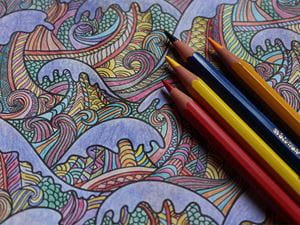
Once used solely to keep the kids occupied, coloring books have now gained a reputation as a valuable therapeutic tool in the mental health community.
The American Psychological Association reports that, as of 2015, Americans are reporting higher stress levels than ever, and that this is causing a variety of health and emotional problems. We’re overworked, over-connected, and overstimulated.
That’s where coloring comes in.
While art therapy has been an accepted form of psychological healing since the 1940s, the mainstream acceptance of adult coloring books is a fairly recent development. The current explosion of adult coloring books owes its genesis to illustrator Johanna Brasford, who debuted her best-selling coloring book, “Secret Garden,” in 2013.
Art therapist Nadia Jenefsky can attest to the effectiveness of coloring.
“People with a lot of anxiety respond really well to coloring books,” she says. “There are some choices involved—in terms of choosing what colors you’re going to use and how you’re blending your colors—but there’s also a lot of structure.”
These books don’t promise to replace a trained therapist or mental health counselor—they’re here to help you relax and keep calm during day-to-day life, especially for those who enjoy creativity, but who may not yet have the confidence to create art from scratch. And thousands can now attest to the power that coloring books hold to temporarily remove the mind from stressful situations and help re-establish a sense of wellness.
Still think coloring books are just for kids? Let’s look at a few of the well-established benefits of coloring within the lines.
It Promotes Mindfulness
Mindfulness is the simple act of fully attending to the present, and is one of the most effective ways to manage stress on a daily basis. It keeps us in the now, so that we don’t obsessively dwell on the past or future.
This state can be cultivated through a variety of proven techniques, such as meditation or walking, but one of the most recent is—you guessed it—coloring.
Established mindfulness exercises help you to engage with the present by noticing and focusing on something around you, like the tree outside your window or the way that you breathe. While doing this, the mind will wander, but it should always be brought back to the object of focus without judging or being distracted by the content of those wandering thoughts. For one who is practicing mindfulness, the focus is all that exists.
Coloring works much the same way—while moving your crayon, pen, or colored pencil through the intricate shapes on the page, your mind is focusing, often to the exclusion of unpleasant thoughts and the feelings which accompany them.
If you want an easy, fun way to refocus your thoughts through mindfulness, grab a coloring book or two and get coloring.
It Shuts Down the Fight or Flight Response
Coloring books are wonderful stress management tools for those with issues such as PTSD and anxiety.
This is because coloring calms activity in the amygdala, a part of the brain that handles the “fight or flight” response. This response is a condition in which the body is in a heightened state of panic and hyper-vigilance—it’s your brain trying to help you fight against something dangerous or, alternatively, to help you flee from it.
This can lead to inflammation—a state in which the body has been overstimulated by stress hormones, and is harming and exhausting itself. You may already know that inflammation is the root of many disorders, including asthma, high blood pressure, Alzheimer’s, and arthritis, and is a silent killer.
Intense focus on a simple, harmless activity, like coloring, disarms the amygdala, which, in turn, calms our bodies and brains. This response is so powerful, in fact, that a 2006 study found that mindfulness art therapy for cancer-stricken women significantly decreased the physical and emotional symptoms felt during their treatment.
Color can heal.
As an added benefit, once we’re calm, coloring can even activate and train our higher functions such as problem solving and fine motor skills—a great benefit for those who are injured.
Coloring is great for your brain in so many ways—even as an adult. Don’t hesitate to try it!
It Gives Us Simplicity
Finally, coloring can grant peace by providing childlike simplicity.
When you sit down to color, you’re instantly transported back to the stress-free days of childhood, and as long as those memories are happy for you, this can be incredibly calming.
We have a cultural stigma about being seen as “childish”—we equate it with incompetence. But that’s just not true. Being an adult means planning for the future, thinking critically, and acting responsibly toward others, but the fun activities of our childhoods do not take away from these qualities.
In fact, acting like a kid can make for a pretty good life.
Warning: if you can break through this cultural taboo and try out a coloring book for a few hours as an adult, you might just find yourself running barefoot in the grass, exploring the woods, and playing imaginative games with your friends.
In our overcomplicated world, a little childlike simplicity can go a long way toward generating a sense of wellness and peace. Let coloring be your first step toward this.
Coloring Peace
The idea of prescribing adult coloring goes all the way back to the famed psychologist, Carl Jung, who thought the this therapeutic technique might be able to connect patients with their subconscious. And although research is still underway concerning exactly how this might work, and how much coloring benefits us, the evidence is mounting that this might be one of the better—and more fun—ways to manage stress at home.
So the next time you’re at Barnes & Noble and you see that set of coloring books on the shelf, don’t laugh or jeer. Pick one up, take it home, and discover one of the newest ways to find peace in our chaotic world.

